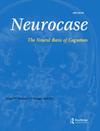知道和不知道:视频反馈作为偏瘫患者持续性病感失认的神经康复的一部分的实际反思。
IF 0.8
4区 医学
Q4 CLINICAL NEUROLOGY
引用次数: 0
摘要
我们报告的情况下,DT,一个男人在他的五十谁遭受了一个大的右额顶叶出血,导致密集的左无力和持续的病感失认产生偏瘫。DT参与了几次视频反馈会议。视频反馈疗法在先前报道的病感失认病例中取得了成功,导致立即和持久的解决。在目前的病例中,观察到类似的戏剧性效果,但随后又出现了病感观念的复发。本病例揭示了病感失认症中涉及的神经学和心理学机制的相互作用,以及参与这种形式的康复治疗的一些实用情感考虑。本文章由计算机程序翻译,如有差异,请以英文原文为准。
Knowing and not knowing: practical reflections on video based feedback as part of neuro-rehabilitation in a case of persistent anosognosia for hemiplegia.
We report the case of DT, a man in his fifties who suffered a large right fronto-parietal hemorrhage, resulting in a dense left weakness and a persistent anosognosia for the resultant hemiplegia. DT engaged in several video-feedback sessions. Video feedback therapy has been successful in previously reported cases of anosognosia, resulting in immediate and lasting resolution. In the current case, similarly dramatic effects were observed, but with a subsequent recurrence of the anosognosic ideation. The present case sheds light on the interplay of neurologic and psychological mechanisms involved in anosognosia and on some of the pragmatic emotional considerations of engaging in this form of rehabilitative therapy.
求助全文
通过发布文献求助,成功后即可免费获取论文全文。
去求助
来源期刊

Neurocase
医学-精神病学
CiteScore
1.40
自引率
12.50%
发文量
70
审稿时长
6-12 weeks
期刊介绍:
Neurocase is a rapid response journal of case studies and innovative group studies in neuropsychology, neuropsychiatry and behavioral neurology that speak to the neural basis of cognition. Four types of manuscript are considered for publication: single case investigations that bear directly on issues of relevance to theoretical issues or brain-behavior relationships; group studies of subjects with brain dysfunction that address issues relevant to the understanding of human cognition; reviews of important topics in the domains of neuropsychology, neuropsychiatry and behavioral neurology; and brief reports (up to 2500 words) that replicate previous reports dealing with issues of considerable significance. Of particular interest are investigations that include precise anatomical localization of lesions or neural activity via imaging or other techniques, as well as studies of patients with neurodegenerative diseases, since these diseases are becoming more common as our population ages. Topic reviews are included in most issues.
 求助内容:
求助内容: 应助结果提醒方式:
应助结果提醒方式:


